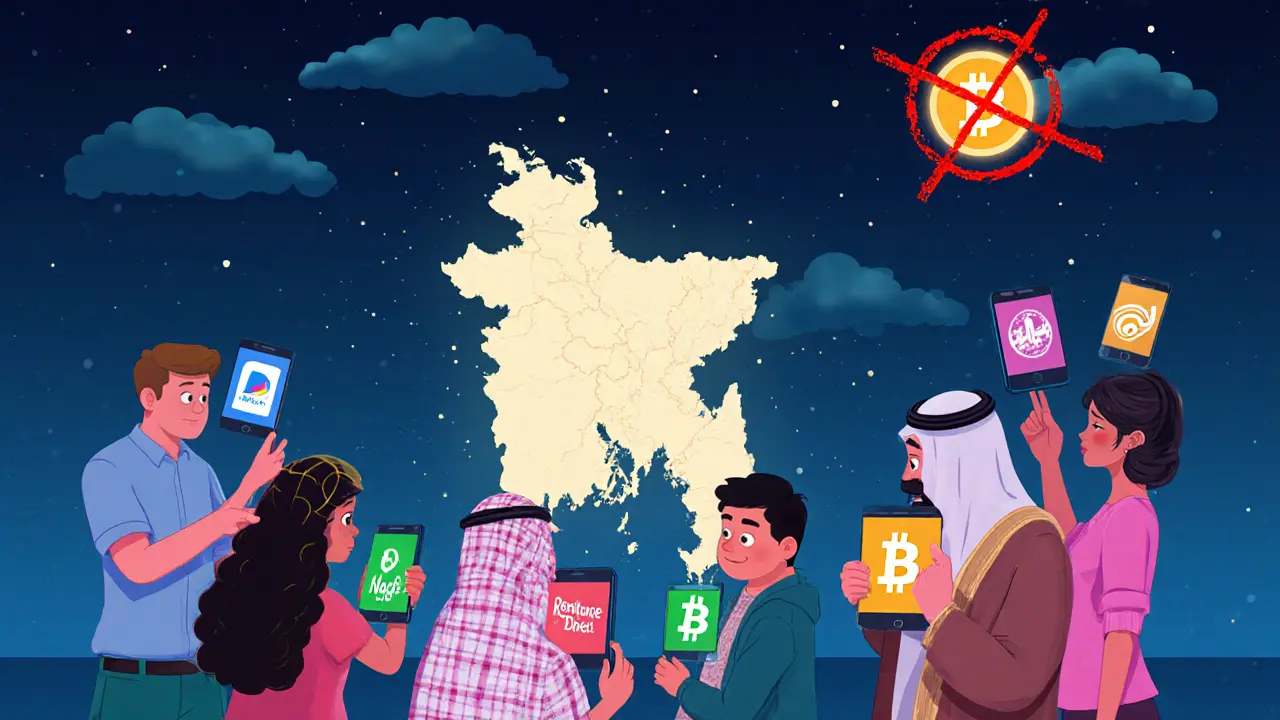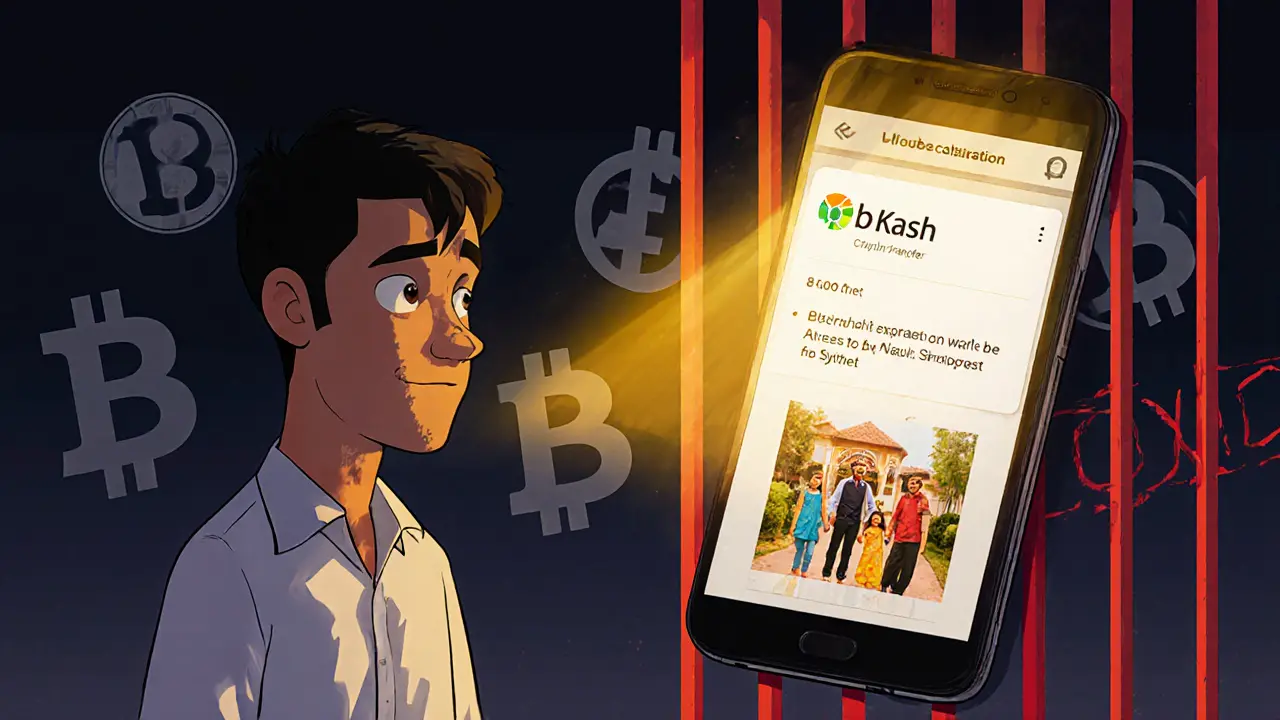Remittance Cost Calculator
Send Money to Bangladesh
See how much you could save with regulated remittance services
Results
For millions of Bangladeshis working abroad, sending money home isn’t just a transaction-it’s survival. In fiscal year 2025, Bangladesh received a record $30 billion in remittances. That’s more than the country earned from its entire ready-made garment industry. Families in Sylhet, Khulna, and Chittagong rely on these funds to pay for food, school fees, and medical bills. But here’s the catch: even as remittance inflows hit all-time highs, using cryptocurrency to send money home is still illegal.
Why Remittances Are So Big in Bangladesh
Bangladesh’s remittance boom didn’t happen by accident. It’s the result of a deliberate shift in policy. Between 2023 and 2025, the central bank, Bangladesh Bank, cracked down on informal money channels like hundi, a traditional underground system that moved billions outside the official banking network. At the same time, they made formal channels faster and cheaper. Mobile apps like bKash and Nagad now let workers in the UAE, Saudi Arabia, and the U.S. send money directly to a recipient’s phone in under an hour.By July 2025, remittance inflows hit $2.48 billion in a single month-up nearly 30% from the same month the year before. The first nine months of FY2024-25 brought in $21.77 billion, compared to just $17.07 billion in the same period the year before. That’s not growth. That’s a surge.
Why? Three things: competitive exchange rates, better digital tools, and the collapse of informal networks. The government didn’t just encourage formal remittances-they made the old ways risky and unreliable. And it worked. Foreign exchange reserves jumped to $25.63 billion, helping stabilize the taka and reduce inflation.
The High Cost of Sending Money Home
Even with all this progress, sending money to Bangladesh still costs too much. The average fee is 6.5%, according to the World Bank. That means for every $100 sent, $6.50 disappears in fees. The global target? 3%. Bangladesh is still nearly double that.Users report mixed experiences. One worker in Dubai told Reddit he sent $500 via bKash and got it credited in 12 hours. Another in the UK said he paid 7% on the same amount, even though the official exchange rate was better. The problem isn’t just the fee-it’s inconsistency. Banks and agents often offer different rates, and some recipients wait days for funds to appear.
There’s a new app, Remittance Direct, launched by Bangladesh Bank in August 2025. It’s cutting fees to 3.8% on average, which is below the market rate. It’s also faster-processing 85% of transfers in under four hours. But adoption is still low. Most users stick with the apps they know, even if they’re expensive.

Why Crypto Is Still Banned
Here’s where things get complicated. While remittance channels are improving, cryptocurrency remains completely off-limits. Since 2017, Bangladesh Bank has banned all crypto transactions under Section 33 of the Foreign Exchange Regulation Act. In September 2025, they issued a new warning: any company caught facilitating crypto remittances faces license revocation and criminal charges.Why? The central bank says crypto threatens monetary control and financial stability. They argue that digital currencies can’t be tracked, regulated, or taxed. Unlike bank transfers, which leave a paper trail, crypto transactions are anonymous and irreversible. That’s a nightmare for regulators trying to prevent money laundering and terrorist financing.
There’s also a political layer. After the 2024 political transition, the government moved aggressively to bring all financial flows under state control. Informal systems like hundi collapsed. Crypto would be the next informal system-and it’s one they won’t tolerate.
Compare this to neighbors like India and Pakistan. Both have started exploring regulated crypto use for remittances. Bangladesh? Not even close. The governor of Bangladesh Bank said in October 2025: “Cryptocurrency has no place in Bangladesh’s remittance ecosystem for the foreseeable future.”
What People in the Diaspora Think
The ban isn’t popular among expats. A Facebook group with over half a million Bangladeshi expats found that 63% are frustrated with high fees and slow transfers. But only 12% have tried crypto. Why? Fear. They know the risk. Getting caught could mean fines, account freezes, or worse.Some try to use peer-to-peer crypto platforms, converting Bitcoin or USDT to local currency through unofficial traders. But these deals are risky. Scams are common. One user on Prothom Alo’s forum lost $300 in fees and waited 10 days for a $500 transfer that never arrived. He didn’t use crypto-he used a middleman. But the pain point is the same: the system is broken.
There’s no real alternative. If you want to send money legally, you use bKash, Nagad, or a bank. If you want speed and lower fees, you risk it on the black market. Crypto isn’t an option-it’s a crime.

What’s Next for Remittances in Bangladesh
Bangladesh Bank has a clear roadmap: get 95% of remittances digital by 2027. They’re expanding the Real-Time Gross Settlement system, cutting transfer times from days to hours. They’re also working with India’s UPI system to make sending money from Indian workers easier.But they’re not planning to touch crypto. Not now. Not next year. The central bank is watching CBDCs-central bank digital currencies-but even those are years away. Their focus is on making the current system better, not replacing it with something uncontrolled.
Experts are divided. Some say the remittance boom is real and sustainable. Others warn it’s fueled by temporary factors: political changes, global labor demand, and a one-time crackdown on hundi. If those fade, growth could stall.
One thing is certain: Bangladesh’s remittance system is now the most efficient in South Asia. It outperforms Pakistan and Nepal. But it’s still expensive, inconsistent, and closed to innovation.
Why This Matters Beyond Bangladesh
Bangladesh’s story isn’t just about money. It’s about control. In a world where crypto promises freedom from banks, Bangladesh chose the opposite path: total state oversight. They didn’t just allow digital payments-they mandated them. And they used regulation, not technology, to force change.For other developing countries watching this, the lesson is clear: you can modernize remittances without crypto. But you need strong institutions, political will, and public trust. Bangladesh built that. And they’re not giving it up.
For now, if you’re a Bangladeshi worker abroad, your best bet is still bKash, Nagad, or a bank transfer. Crypto might be faster, cheaper, and more private. But in Bangladesh, it’s not worth the risk.
Is it legal to use crypto for remittances in Bangladesh?
No, it is not legal. Bangladesh Bank has banned all cryptocurrency transactions since 2017 under the Foreign Exchange Regulation Act. Any entity or individual facilitating crypto-based remittances risks license revocation, fines, and criminal prosecution. The ban was reinforced with a new warning notice in September 2025.
Why does Bangladesh ban crypto but allow digital remittances?
Digital remittances through apps like bKash and Nagad are fully regulated and traceable. Every transaction is tied to a user’s National ID, mobile number, and bank account. Crypto, by contrast, is anonymous and decentralized. The central bank can’t monitor it, tax it, or stop illicit flows. They want control-not chaos.
How much do remittances cost in Bangladesh on average?
The average fee is 6.5%, according to the World Bank’s 2024 data. This is nearly double the global Sustainable Development Goal target of 3%. Newer platforms like Bangladesh Bank’s Remittance Direct app have lowered fees to 3.8%, but most users still pay 5-7% through traditional agents and banks.
What’s the biggest challenge in sending remittances to Bangladesh?
The biggest challenge is inconsistent exchange rates and hidden fees. Even when the official rate is favorable, banks and agents often offer worse rates to pocket the difference. Processing delays also remain common, especially for smaller transfers. Rural recipients often lack the digital literacy or documentation needed to access funds quickly.
Could Bangladesh ever allow crypto remittances in the future?
Not anytime soon. Bangladesh Bank has shown no interest in relaxing its crypto ban. While they’re exploring central bank digital currencies (CBDCs), they’ve made it clear that private cryptocurrencies like Bitcoin or USDT will not be permitted. The central bank views crypto as a threat to monetary sovereignty and financial stability, not a solution.
Which countries send the most remittances to Bangladesh?
The Middle East dominates, accounting for 68.3% of all remittances. Saudi Arabia, the United Arab Emirates, and Qatar are the top three sources. The United States contributes 12.7%, and Malaysia adds 8.4%. Together, these regions supply over 90% of Bangladesh’s remittance inflows.

Brian Gillespie
November 12, 2025 AT 13:44Ainsley Ross
November 12, 2025 AT 21:43It’s not about control. It’s about protecting people who can’t protect themselves.
Wayne Dave Arceo
November 13, 2025 AT 09:35Joanne Lee
November 15, 2025 AT 02:26I’m curious if the government is actively monitoring P2P channels or just relying on fear.
Laura Hall
November 16, 2025 AT 19:34also why is no one talking about the fact that remittance direct has 3.8% but nobody uses it? because people don’t trust government apps. they trust bKash because it’s fast. period.
Arthur Crone
November 17, 2025 AT 19:27Michael Heitzer
November 19, 2025 AT 01:29And yes - it’s not perfect. But it’s ours. And it’s working.
Rebecca Saffle
November 20, 2025 AT 09:16Adrian Bailey
November 22, 2025 AT 07:45Rachel Everson
November 22, 2025 AT 21:35Here’s what you can do: push for transparency. Demand better rates from your remittance provider. Share info about Remittance Direct. Tell your friends. Change doesn’t come from breaking rules - it comes from making the system better from within.
Johanna Lesmayoux lamare
November 24, 2025 AT 16:02ty ty
November 26, 2025 AT 15:50BRYAN CHAGUA
November 26, 2025 AT 19:49Arthur Coddington
November 28, 2025 AT 13:48Diana Dodu
November 30, 2025 AT 02:05Raymond Day
November 30, 2025 AT 20:22